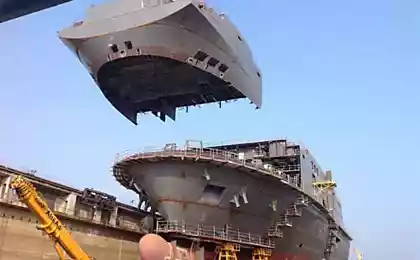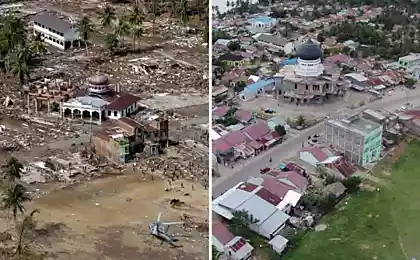3483
Picaso 3D-Builder - Made in Russia
Today's story is about another very interesting and worthy of 3D-printers, which previously Habré hardly mentioned, and the creators of which I recently had a chance to talk a little bit.
Picaso 3D-Builder h4>

left in the cold 0.25mm, 0.20mm Right warm. "Cold" model visually and to the touch looks smoother and has fewer defects. I>
Everything in the garden, in the winter! © i>
That's all.
The End.
Source: habrahabr.ru/post/203698/
Picaso 3D-Builder h4>
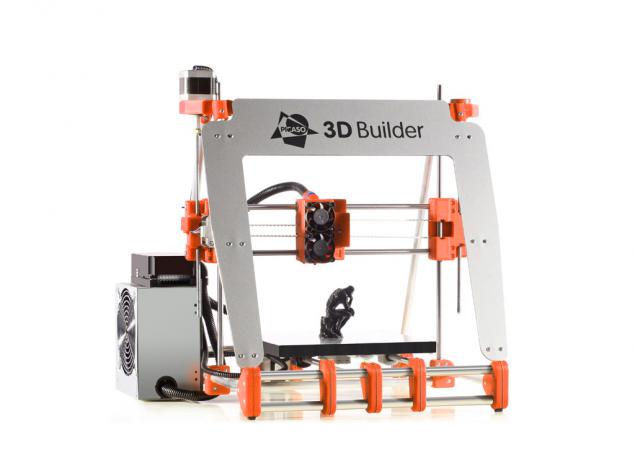
A distinctive feature of this printer is its Alma Mater, namely:
- Although it is not difficult to guess by looking at the picture, the basis and was taken classic Prusa Mendel, all subsequent "treatment of a file" was designed exclusively Russian team;
- printer has a 100% Russian production cycle. Yes, do not be surprised, this is true. And what are the advantages and disadvantages of such a decision followed I just tell forth;
- and the printer is equipped with its own software for working Picaso Polygon . The software is closed and recalled Repetier-Host , but unlike the latter contains a set of presets specifically for Picaso 3D-Builder. < /
First, let's talk about the design features. H5>
As I said earlier, at the heart of the design Picaso 3D-Builder is a classic Prusa Mendel, but with some improvements.
No changes are many, but each of them are not very bad.
And all production printer, as usual, is concentrated in the glorious city of Zelenograd.
So - Farm h6>
Farm itself is virtually identical to his grandfather Mendel. Changes undergone plastic parts of the farm. They have a nice orange color, and produced a massive cast, and are not printed on the printer that has a positive effect on quality. At the same time the manufacturer has 3D-models of these components and can provide users * .STL file for self-printing, if necessary, for example for repair.
Also fortified farm U-shaped aluminum frame. Wherein the frame is not fixed in the Z-axis plane, as new Prusa i3 , and on the front edge side of the triangle.
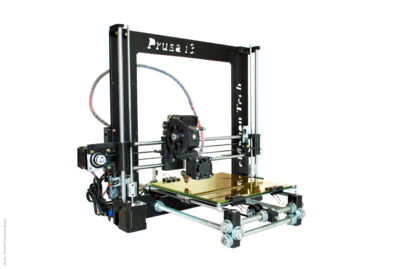

Prusa i3 ______________________________________________________________________ 3D-Builder i>
Here the question is rather design. Combined with orange details 3D-Builder looks nicer Prusa i3 and even has a higher hardness because retained triangular farm on the sides.
Printhead h6>
This is where our craftsmen have worked on glory.
First, let's talk about the extruder. I>


As you can see in the picture, all the moving elements of the extruder closed body of the printhead. This is a definite plus, since dust does not fall on a pair of gear. The extruder is not a "once-through", in contrast to the more budget and more popular options where ribbed bolt is attached directly to the motor shaft, but on the contrary, has two ribbed roller and both leading through the gearbox.
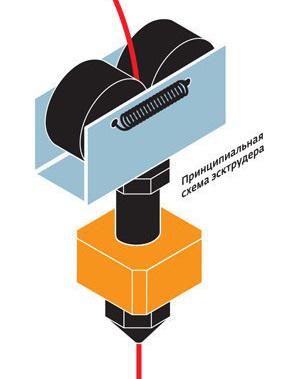
Under this scheme jam bar or "obstruction" is virtually eliminated.
A "once-through" extruder, no matter how you conjured driver motor extends rod jerks, that certainly affect the quality of your model. Reducer, to some extent, to minimize this effect. If you do decide on a once-through an extruder, make sure that driver stepper motor support 1/32 pitch or greater.
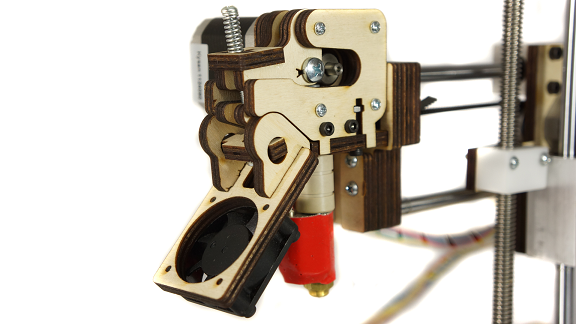
For comparison - the new wooden straight-through extruder Printrbota. I>
Now the hot end and the auto-calibration. I>
Here it is all really interesting. The hot end with a portion of the printhead and sensors to the Z-axis to form an original system of self-calibration. Which one, the developer does not disclose, citing the know-how and disassemble 3D-Builder personally I have not yet succeeded. Auto Calibration itself takes place before the beginning of each print, as an element of parking. So whatever happens to your table and the nozzle when you do not change the nozzle geometry and whatever it did not have, no matter how Kapton or other table cover, you did not use, the height of the nozzle tip on the table will always meet the established parameters when any circumstances.
It ends its hot company Picaso offers several different nozzles from 0.30 mm (note from the 0.30 mm!) For fast printing of up to 0.15 mm for quality.
I especially liked the ventilation. I>
But only the lower part.
Ceiling fan, as usual, in the old, blowing a very hot end and creates a temperature gradient in the upper part, while minimizing the size and influence of the "plug" in the process of passing the bar ( Read more details here , in the" Entertaining rheology "). However, as I wrote in previous articles, the gradient and so is created due to the local heating rods and fan application can be replaced by using a massive hot end, preferably ceramic as Ubis Hot End . But this time will be on the conscience of developers.
Much more interesting is the lower fan!
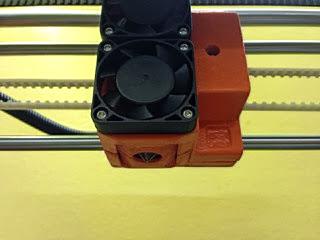
Through a system of channels in the printhead body, it creates an annular and uniform airflow pattern directly in the press. And just as opposed to the fan located on the side of the extruder brackets - does not create gradients in the area of printing and allows the plastic to harden evenly in all directions and with minimal deformation.
From my own experience I would say that any fan separately imposed leads to defects in the printing, for example, that such structures.
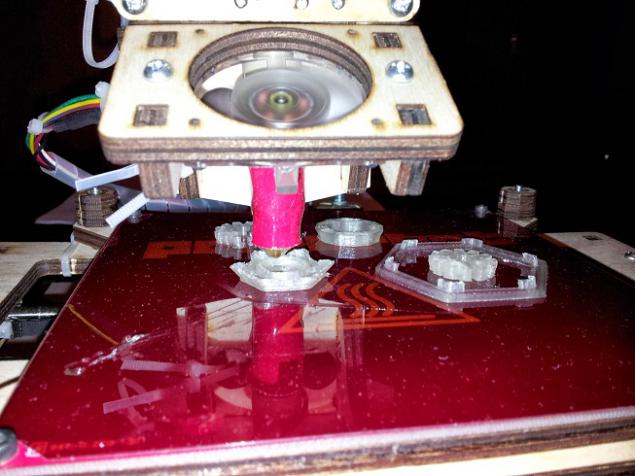
In the case of my Printrbotom where fans submitted ahead of the extruder, the rear "horns" of thin models always tend to curve forward in the process of printing. It is in some cases leads to oblomu horns or failure of the entire model from the table, when the nozzle hits the curved horn too.
Note: i> h6> I mostly print and cite examples of plastic PLA. It is safer ABS, non-toxic and biodegradable. Models of PLA always look more rough than that of the ABS, but in case of the transparent plastic - the effect is visually enhanced. I>
Hot table h6>
Everything is in accordance with the best fashion trends in homes Landon. The table is made of a single piece of aluminum, and the heater is disposed inside. Thus the table will not deform when heated, heated very evenly and keeps the temperature.

Aluminium really fat. I>
Another feature of the table is the material which it is coated. It is not Kapton and some synthetic material having a greater adhesion to ABS and PLA. The composition of the material manufacturer keeps a secret, but sells it as users wear 3D-Builder'a. Here is such an exclusive.
And yet, yes, the table has a size of 20 x 20 cm, which distinguishes your printer from the competition for the better. Size, Mother Russia has always been rich, and on the stand.
Stepper motors h6>
Here I want to say is that the Z axis is used only one motor. The second screw (as the construction of farm U-shape) is driven by a belt drive. The design, in my opinion not the best. Belts are not absolutely rigid, and when they start to deteriorate, the second lag screw will be more noticeable, which may lead to misalignment of the horizontal axis, and make the appropriate defects in the geometry model.

Electrical h6>
Here everything is quite pretty. The printer is powered by a standard ATX power supply, which in turn is an integral part of the design, which can not but rejoice. The controller board is in a separate compartment, which is attached to the power supply. All wires collected in flexible cable channels. The board has a connector to connect your LCD display, but the display itself is not supplied by the manufacturer. WiFi, unfortunately, is not supported.

a simple and tasteful. I>
Now a little about the production h5>
As I said, the printer has a 100% Russian production cycle.
On own capacities molded plastic parts and farm produced some elements of design, final assembly and packaging of the printer.
The controller board is printed as in Russia, znamodelo - in Zelenograd. There is made U-shaped aluminum frame and the table top.
Stepper motors, of course, Chinese.
As a consequence, the manufacturer has its own service and technical support, and a virtually unlimited supply of original spare parts. Again, if you make any changes to the design (of course, and only improved)), you can quickly order and receive a new part straight, so to speak, from the machine. From my own experience I would say that the technical support is adequate enough, knows his product and software to the printer. In any case, the voice of the master 20 minutes never broke, no one threw a tube, but calmly and clearly explain how it works and why you need auto-calibration presets in the software.
More in production, I would mention the bars. The manufacturer supplies a lot of different colored rods ABS and PLA in China. Why Chinese? Because, according to the manufacturer, at the stage of development they have tried many printer suppliers, and Russian, and German, and eventually settled on Chinese suppliers, reliable and high quality. I can not yet say anything about it. I ordered a pair of reels PLA, try to accomplish your goal. But the bar is really always available and any color. Celestial in this regard is not fail, arbeiten in Stakhanov, so to speak.
Software Picaso Polygon . H5>
And here, perhaps, the most interesting. The manufacturer has in its arsenal of its own software, the type of Repetier-Host , ie add-on Slicer Slic3r.
In the Polygon derived not all parameters Slic3r, but only the most common and most frequently editable - print speed, thickness, percentage of coverage and some more. The rest of the set of parameters "hardwired" in the presets, which the manufacturer recommends to choose from depending on the specific task. But this, of course, for ordinary laymen, for those who just want to print high quality and advance. For left-handers - Please, you can dig into the settings Slic3r directly, it is not forbidden. Replacing Slic3r made a copy of the new version in the same folder slicer.
With presets developer really surprised ... quality thin-walled structures, the truth of the ABS, delivers.
On Printrbote me this has not yet happened ... Shaman, Ma. And the size still matters.
In addition to the presets, Polygon for Builder contains a separate operation caused by typical printer, such as the replacement of the nozzle - the printer warm up the extruder, with the team when it is possible to replace the nozzle, then thrust out a little plastic, calibrate, cool. Or feed the new bar - warm up, grab bars, stretch, calibrate, cool. And so on.
In general, the approach to the software, despite the austerity of design, pleasantly surprised. As if for himself.
Unfortunately, the software is closed. It is not clear why, after his successful community could be improved and further developed, as well a variety of CC licenses would allow it to monetize, where necessary, for example, the market for B2B.


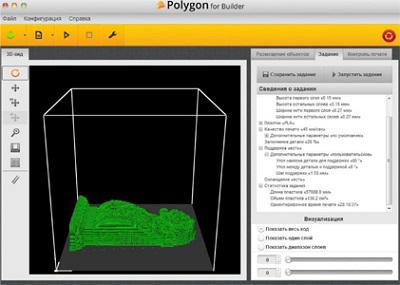
Conclusion h5>
The conclusion is, in fact, this - 3D-Builder surprised!
Indeed, on the sly, especially anywhere without advertising, was born on Russian soil, I grew up and took a worthy place among strangers, in the best traditions of ancient tales. Yes, and with self-calibration and blowing ring model. Opensource projects, eh ... I want to give one such AvtoVAZ.
Note: i> h6> If anyone knows, I'm the owner of the Lada grants. I>
Oh, and for dessert h5>
Amuse your, and our, so to speak, self-esteem and sense of patriotizma as for whom goose crackling with corduroy, but someone on a low-calorie and modest Pavlovich, I hasten to inform preinteresneyshuyu knows that at the production facilities Picaso ends next assembly and packaging, and 50 new printers Picaso 3D-Builder, and they will be implemented starting this week with a slight discount, about 10-12%.
By Christmas sale, so to speak, not otherwise.


On the website Picaso is no such information, but orders a discount is already taking.
It is on this positive note about this extraordinary and unique novelty of domestic and not ashamed of the word - a highly technological production, resolve and finish.
P.S. I> h5>
But for those who are interested in my further creative exploration with Printrbotom, I can report the following.
About Slic3r h6>
Recently he released the release candidate Slic3r. It includes two interesting options for generating perimeters and generally updated the algorithm. The smoothness of the models has increased significantly, and even the naked eye.

The old problem with the start of the perimeter over the precipice - disappeared. But there were, as usual, new. Now increases the slicer slaysenga exponentially depending on the number of print objects (ie downloaded files STL). If one object slicing takes 1-2 minutes, then slicing ten similar objects took me over 120 minutes, ie geometric progression with 1.6 - 1.65. If you keep all 10 objects in the 1 * .STL or * .OBJ file and then load into slaysel, but as a single entity, while slaysenga reduced to 40 minutes. Obviously, this is some bug resulting from a permanent allocation of previous layers separately loaded models.
In addition, if given any acceleration for perimeters and filling, the slicer is now swears to "0" in the acceleration by default, and now I put 9,000 mm / s / s.
But Muse Isaakovna strongly advises not to lose hope and to hope for a speedy final release Slic3r.
What we are inspired and follow.
About cold h6>
With the onset of cold weather in Moscow had a chance to check out the stable long-standing idea of the effect of ambient temperature on the quality of the models. Printrbot Jr was brought to the balcony and charged five-hour model with an air temperature of about 6 degrees.
The result was quite predictable:
- the number of defects in difficult areas decreased;

left in the cold 0.25mm, 0.20mm Right warm. "Cold" model visually and to the touch looks smoother and has fewer defects. I>
Everything in the garden, in the winter! © i>
That's all.
The End.
Source: habrahabr.ru/post/203698/
Still, social advertising, who would not say a thing very necessary
Awkward feeling when your lecturer - Lord of the Sith

























